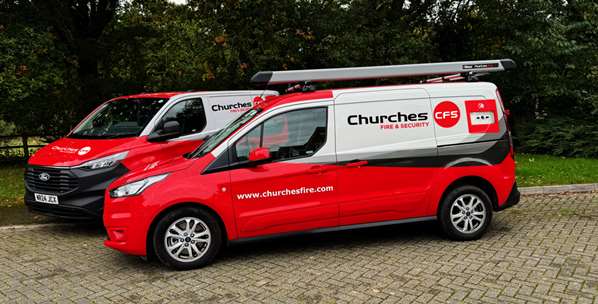
As you can imagine, as part of my role at Sabio Group, I’ve seen my fair share of customer service transformation projects.
But when approached by Churches Fire & Security about implementing new customer service infrastructure in the form of a new contact centre, something didn’t quite add up.
Here’s why we took a completely different approach – and how it paid off.
Trust Us: We’re The Experts
Let me paint you a picture: Churches Fire & Security, the UK’s only fully integrated fire safety company, was experiencing significant growth. Like many expanding businesses, they were facing increasing pressure on their customer service team. The natural response? Invest in new technology. It’s a pattern I’ve seen countless times – when service levels are strained, the reaction is often to replace the entire system.
But here’s the thing about customer service transformation: sometimes the answer isn’t in new technology, but in understanding what’s actually happening on your front line. That’s why when Churches approached us, instead of immediately drawing up plans for a new infrastructure, we suggested something that might have seemed counterintuitive at first, but which would benefit Churches in the long run – we analysed why their customers were actually calling instead.
Knowledge is Power
This is something I’m particularly passionate about: data-driven decision making. Our proposed project was to launch into a programme that would surface insights into customer behaviour – providing key data that Churches (and other organisations for that matter), with the best of intentions, did not fully know. That was specifically, the exact reasons as to why their customers were calling in.
It’s fascinating how often organisations think they know why customers are contacting them, only to discover a completely different reality when they look at the data.
We implemented our Intent Capture & Analysis (IC&A) solution, our own solution powered by Sabio Console using Google Cloud’s Dialogflow technology. What makes this approach unique is its ability to integrate invisibly with existing systems – we can start gathering insights almost immediately, without disrupting any ongoing operations.
Eye-Opening Results
After analysing 25,000 calls, we discovered that 17% of all incoming calls annually were simply requests to test fire alarms. Think about that for a moment: the single biggest reason for customer contact was something that could potentially be handled through their online portal.
But that wasn’t all. We found that billing and invoice payments were the second most common reason for calls, and a substantial 33% of contacts involved various ‘long tail’ call types. Perhaps most crucially, we uncovered that 60% of customers were making multiple calls, with 83% of repeat callers requesting fire alarm service having already called at least once for the same issue.
This is where the real value of our approach becomes clear. Instead of implementing a new system that would have been costly for Churches – and potentially would have preserved all of these inefficiencies but in a shiny new wrapper – we were able to identify specific areas for targeted improvement.
Game Changing IC&A
The transformation has been remarkable to witness. In a recently published case study, Churches’ CEO, Charlie Haynes, put it perfectly when he said: “The IC&A solution has been a game-changer for us. The insights we gained have allowed us to make data-driven decisions, prioritise automation efforts, and ultimately improve the experience for both our customers and employees.”
What I find most satisfying about this project is how it exemplifies one of my core beliefs about digital transformation: sometimes the most innovative solution isn’t about implementing new technology, but about understanding how to optimise what you already have. By taking a step back and really analysing the actual reasons behind customer contacts, we helped Churches avoid an unnecessary system overhaul and instead focus on targeted improvements that would make a real difference.
So, What’s Next?
Looking ahead, Churches is now perfectly positioned to implement automated solutions that address actual customer needs rather than perceived ones. They’re working on PCI-compliant payment software integration, online self-service options, and various other improvements – all based on solid data about what their customers actually need.
For me, this project reinforces something I’ve long believed about customer service transformation: the key to success isn’t always about having the latest technology – it’s about truly understanding your customers’ needs and behaviours.
Sometimes, you need to stop, look, and listen before you leap into technological change. In Churches’ case, what could have been a potentially wasted investment has instead turned into a masterclass in smart decision-making.
Could your transformation be next? Read our latest case study with Churches Fire & Security.
About the Author
 Kevin McGachy is Head of AI Solutions at Sabio Group.
Kevin McGachy is Head of AI Solutions at Sabio Group.
Sabio Group is a global digital customer experience (CX) transformation specialist with major operations in the UK (England and Scotland), Spain, France, Netherlands, Malaysia, Singapore, South Africa and India.
 The Group, which includes ‘makepositive’, delivers solutions and services that seamlessly combine digital and human interactions to support exceptional customer experiences.
The Group, which includes ‘makepositive’, delivers solutions and services that seamlessly combine digital and human interactions to support exceptional customer experiences.
Through its own technology, and that of world-class technology leaders such as Avaya, Genesys, Verint, Twilio, Google, Amazon and Salesforce, Sabio helps organisations optimise their customer journeys by making better decisions across their multiple contact channels.
The Group works with major brands worldwide, including Aegon, AXA Assistance, Bankia, BBVA, BGL, Caixabank, DHL, loveholidays, Marks & Spencer, Rentokil, Essent, GovTech, HomeServe, Sainsbury’s Argos, Telefónica, Think Money and Transcom Worldwide.





